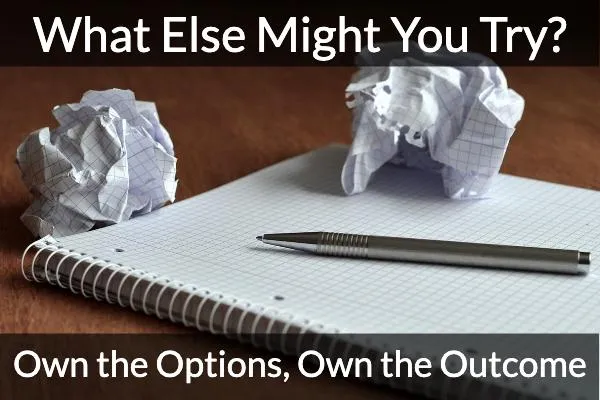
"What Else Might You Try?": Helping People Generate Options for Getting Unstuck
If you're running a team, maintaining your composure is your single most important skill. The slowest heart rate in the room runs the room. I help leaders manage their triggers so they run their teams more effectively.
When someone you care about is struggling or stuck, you naturally want to help. But giving advice and motivating them can backfire; undermining their ownership and preventing them from developing their independent capability.
In previous editions of this newsletter, we've talked about the early stages of the change process: getting their permission to have the conversation, focusing on an energizing outcome, and exploring the history of the problem and their prior attempts to solve it.
And we've also talked about the big mindset you bring to such conversations: that problems are opportunities to achieve even bigger and better outcomes than simply making the problems go away.
Once these opportunities are identified, it's time to build the plan. And it's a moment when the most patient and empowering coach can fall victim to what Michael Bungay Stanier calls the "Advice Monster."
But it's not time for your advice yet. The most important thing to accomplish at this stage is to guide your conversation partner to come up with new ideas to try.
So ask, "Given this opportunity that you've identified, what might you try?"
That question kicks off Task 1: Identify Options, the first of three tasks in Step 4 of the change process in my and Peter Bregman's book You Can Change Other People. When we ask it—and then keep asking it—it does far more than generate ideas. It activates the four powers of change:
- Ownership (they write the list, so they own the outcome)
- Independent capability (every idea is a rep in creative problem‑solving)
- Emotional courage (naming scary options builds nerve)
- Future‑proofing (the process itself becomes a reusable playbook)
1. Open the tap: “What might you try?”
Start with a try question, not a do question. Try separates brainstorming from deciding, removing the pressure to commit or be right.
2. Lower the bar for success
Creativity withers in the face of criticism. So give explicit permission for “bad ideas, one‑in‑a‑million schemes, outlandish escapades.”
- If they balk, ask: “What would you do if you didn’t care whether it failed?”
- Record every option verbatim without judging its merits: “Great—let’s put it on the list.”
That neutrality rewards emotional courage instead of idea quality.
3. Mine the past
“Remind me what you’ve already tried—hits and flops.” Past experiments are R & D data; even the flops can point to inverse solutions.
4. Play the What‑If game
Remove a constraint: “What might you try if budget were unlimited?”
Add a constraint: “What if you had zero dollars and had to do something by Friday?” Constraints spark elegant, low‑cost moves.
5. Celebrate Opposite Day
Ask, “What would definitely not work here?” Listing horrible ideas often reveals their useful opposites.
6. Ladder the climb
Big goals can paralyze. Break the climb into rungs: “What can you try this week to be in a better spot next week?” Small wins build independent capability and confidence.
7. Channel fear
“What’s the scariest move you can imagine?” Fear flags high‑leverage action and stretches the emotional‑courage muscle—even if you don’t choose that option today.
Three Options Minimum
Keep going until your conversation partner comes up with at least three possible next steps. One idea isn’t an option; two feels like a dilemma; three unlocks real choice.
Once there are at least three interesting options on the table, then you both put on your critical thinking hats and start evaluating. We'll look at how to do that in an upcoming edition of the Mindset Mastery Memo.
If you'd like master your mindset and become an unflappable, Trigger-Free Leader who brings out the best in the people around you, let's talk. Visit HowieJacobson.com to schedule a discovery call.
